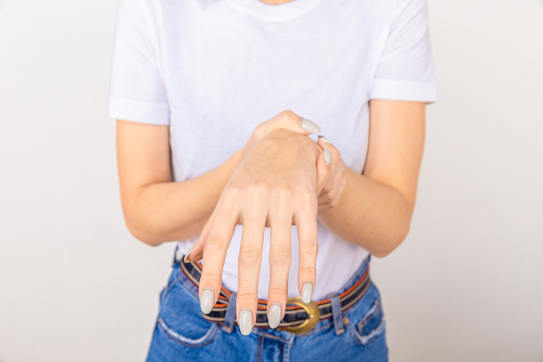Acetone is commonly used as a paint remover and household cleaner. Your body creates acetone during your metabolic process. Your metabolism breaks down fat while your liver creates ketones. These ketones are filled with acetone.
Acetone can be absorbed through the skin. In small amounts, the acetone will absorb into your liver and get turned into energy. Your skin can get red and itchy causing dermatitis if it is exposed for a long period of time.

What is in Nail Polish Remover?
Nail polish remover has a solvent as an active ingredient that takes the paint off your nail. This job requires a strong solvent to clean off the paint quickly.
What Is Nail Polish Remover Made of?
Nail polish remover is commonly made with acetone. Acetone is a chemical that when exposed to the skin can be harmful. In small doses, the body will absorb the acetone making it harmless.
Nail polish removers are made with different forms of solvents to remove the polish. Solvents found in nail polish remover include acetone, ethyl acetate, and isopropyl alcohol.
These solvents help remove the chemicals in nail polish. You can find chemicals like Formaldehyde, Dibutyl Phthalate, Toluene, Camphor, Ethyl Tosylamide, and Xylene in your nail polish.
What to Do if You Get Nail Polish Remover on Your Skin?
If you get a small amount of nail polish remover on your skin you may see your skin get red or dry. To combat this you can rinse your skin and nail beds with warm water then use a moisturizer. This will seal the skin and give your skin back its moisture.
If your body is exposed to large amounts of acetone either on your skin or breathed in through the mouth or nose it is best to get to a hospital as soon as possible.
Symptoms of Acetone Poisoning
- Headaches
- Confusion
- Being lightheaded or feeling dizzy
- Irritation of the eyes, throat, nose
- High pulse
- Nausea
- Vomiting
- Coma (although this is rare)
Small amounts of exposure on the skin for long periods of time can lead to dry flaky skin irritations called dermatitis. Acetone removes the oils in the skin creating dry spots.
The amount of acetone used in nail polish remover is low and generally is not enough to harm your skin long-term.
Prolonged exposure to acetone on the skin can cause dermatitis and other symptoms.
- Increased sensitivity of the nail bed
- Skin sensitivity around nails
- Dry skin around nails
- Dry nail beds
- Brittle or peeling nails
Is it ok to Use Acetone While Pregnant?
Acetone in small amounts is safe while pregnant. It is advised to wash hands that have been in contact with acetone immediately to ensure minimal absorption.
If nail polish remover or acetone is ingested or extreme exposure happens on the skin it is advised to talk to a doctor as it can harm a fetus.
The FDA has deemed acetone safe in small doses.
How Does Nail Polish Remover Work?
Acetone as mentioned above is a by-product of the body’s metabolism. It is common as a solvent because acetone melts both polar and non-polar substances.
This means acetone breaks down organic and inorganic material.
It is widely used as a solvent because it can mix into the water without decreasing its ability to do its job. It is a byproduct of human biology and is relatively harmless in smaller amounts.
How to Alleviate Dermatitis From Nail Polish Remover
Contact dermatitis comes from contact with a harsh substance or an allergen. It is not common to get contact dermatitis from nail polish remover it is possible.
Symptoms of contact dermatitis include dry skin, itching, redness, and cracking.
The best way to alleviate contact dermatitis is prevention. If prevention is not possible, frequent washing and the use of a moisturizing cream will heal the outer layer of skin.
If you are going to come in contact with acetone you can use protective gel barriers or wash your hands immediately after contact to lower the risk of repeat dermatitis.
Healthy Acetone Alternatives
Nail polish remover has an active ingredient in its makeup that removes polis. In acetone-based removers the active ingredient is acetone. Even in acetone-free options, a solvent is required to remove the paint from your nails.
According to the EPA, acetone is considered a yellow chemical. Yellow means the chemical has been deemed safe enough based on its function and should not be used in excess.
Alternatives to acetone as listed below are considered green circle solvents meaning the chemical is not considered toxic by the EPA.
Alternatives to Acetone Based Nail Polish Removers
- Dimethyl Succinate
- Ethyl Acetate
- Dimethyl Adipate
- Dimethyl Glutarate
- Propylene Carbonate
- Butyl Acetate
- Isopropyl Alcohol
- Methyl Soyate
Many alternatives are infused with essential oils like argan oil and vitamins A, C, and E to alleviate drying of the skin and nail beds. Simply look for an acetone-free option when shopping for nail polish remover.
How to Create Your Own Nail Polish Remover
An at-home remedy to avoid harsh acetone-based nail polish removers is to make your own. You can make your own nail polish remover by following these steps.
- Add ½ a cup of vinegar
- Add ½ a cup of lemon juice
- Stir well
- Let the mixture sit on the polish for up to 5 minutes
- Rub the polish well
- Repeat until polish is removed
Frequently Asked Questions About Nail Polish Remover
Are Nail Polish Removers And Rubbing Alcohol The Same Thing?
Nail polish remover and rubbing alcohol are not the same things. Nail polish remover can be made with rubbing alcohol. The difference is nail polish remover is a mix of ingredients with the addition of a solvent. They cannot be used interchangeably to remove nail polish.
Does nail polish remover stain clothes?
Nail polish remover can stain clothes by bleaching or marking them. Nail polish stains can be removed by using a spot stain remover. Once the area is treated simply wash your clothes as normal and the stain should go away unless it has been sitting.
Can I pour nail polish remover down the drain?
Nail polish remover is considered hazardous material and should not be poured down the drain. Acetone and other nail polish removing solvents can melt plastic causing issues in your pipes.
There are also environmental hazards that come with pouring acetone down the drain. They can negatively impact the ecosystem.
To dispose of acetone you can:
- soak small amounts in a paper towel and throw it away
- leave it in a bowl and allow it to evaporate
RELATED POSTS YOU MIGHT BE INTERESTED IN:
